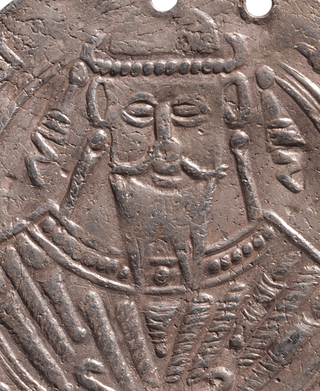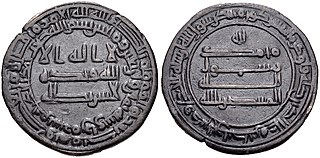Contents
This article needs additional citations for verification .(December 2009) |
| Timeline of the history of Islam: 6th | 7th | 8th | 9th | 10th | 11th | 12th | 13th | 14th | 15th | 16th | 17th | 18th | 19th | 20th | 21st century |
This article needs additional citations for verification .(December 2009) |
| Timeline of the history of Islam: 6th | 7th | 8th | 9th | 10th | 11th | 12th | 13th | 14th | 15th | 16th | 17th | 18th | 19th | 20th | 21st century |

Abū Mūsā Muḥammad ibn Hārūn al-Amīn, better known by his laqab of al-Amin, was the sixth Abbasid caliph from 809 to 813.

Abū al-ʿAbbās Abd Allāh ibn Hārūn al-Maʾmūn, better known by his regnal name al-Ma'mun, was the seventh Abbasid caliph, who reigned from 813 until his death in 833. He succeeded his half-brother al-Amin after a civil war, during which the cohesion of the Abbasid Caliphate was weakened by rebellions and the rise of local strongmen; much of his domestic reign was consumed in pacification campaigns. Well educated and with a considerable interest in scholarship, al-Ma'mun promoted the Translation Movement, the flowering of learning and the sciences in Baghdad, and the publishing of al-Khwarizmi's book now known as "Algebra". He is also known for supporting the doctrine of Mu'tazilism and for imprisoning Imam Ahmad ibn Hanbal, the rise of religious persecution (mihna), and for the resumption of large-scale warfare with the Byzantine Empire.

Abū Isḥāq Muḥammad ibn Hārūn al-Rashīd, better known by his regnal name al-Muʿtaṣim biʾllāh, was the eighth Abbasid caliph, ruling from 833 until his death in 842. A younger son of Caliph Harun al-Rashid, he rose to prominence through his formation of a private army composed predominantly of Turkic slave-soldiers. This proved useful to his half-brother, Caliph al-Ma'mun, who employed al-Mu'tasim and his Turkish guard to counterbalance other powerful interest groups in the state, as well as employing them in campaigns against rebels and the Byzantine Empire. When al-Ma'mun died unexpectedly on campaign in August 833, al-Mu'tasim was thus well placed to succeed him, overriding the claims of al-Ma'mun's son al-Abbas.

Abū Jaʿfar Hārūn ibn Muḥammad al-Wathiq bi'Llah, commonly known by his regnal name al-Wathiq bi'Llah, was an Abbasid caliph who reigned from 842 until his death in 847.

Ja'far ibn Muḥammad ibn Hārūn al-Mutawakkil ʿalā Allāh ; March 822 – 11 December 861, commonly known by his regnal name al-Mutawwakil ala Allah, was the tenth Abbasid caliph, ruling from 847 until his assassination in 861. He succeeded his brother, al-Wathiq, and is known for expanding the empire to its maximum extent. He was deeply religious, and is remembered for discarding the Muʿtazila, ending the Mihna, and releasing Ahmad ibn Hanbal. He is also known for his tough rule, especially with respect to non-Muslim subjects.

Abu Ja'far Muḥammad ibn Ja'far ibn Muḥammad ibn Hārūn al-Muntasir biʾLlāh, better known by his regnal title al-Muntasir biʾLlāh was the caliph of the Abbasid Caliphate from 861 to 862, during the "Anarchy at Samarra". The power struggle between al-Muntasir and his brother, al-Mu'tazz, backed by different factions, climaxed with the Turkic leaders plotting the murder of his father al-Mutawakkil. Following the assassination in 861, al-Muntasir assumed the caliphate with Turkic support.

Abū ʿAbd Allāh Muḥammad ibn Jaʿfar ibn Muḥammad ibn Hārūn al-Muʿtazz bi-ʾLlāh, better known by his regnal title al-Muʿtazz bi-ʾLlāh was the Abbasid caliph from 866 to 869, during a period of extreme internal instability within the Abbasid Caliphate, known as the "Anarchy at Samarra".

Abū Isḥāq Muḥammad ibn Hārūn ibn Muḥammad ibn Hārūn al-Muhtadī bi-ʾLlāh, better known by his regnal name al-Muhtadī bi-ʾLlāh, was the Caliph of the Abbasid Caliphate from July 869 to June 870, during the "Anarchy at Samarra".

Abu’l-ʿAbbās Aḥmad ibn Jaʿfar ibn Muḥammad ibn Hārūn al-Muʿtamid ʿalā’Llāh, better known by his regnal name al-Muʿtamid ʿalā ’llāh, was the caliph of the Abbasid Caliphate from 870 to 892. His reign marks the end of the "Anarchy at Samarra" and the start of the Abbasid restoration, but he was largely a ruler in name only. Power was held by his brother al-Muwaffaq, who held the loyalty of the military. Al-Mu'tamid's authority was circumscribed further after a failed attempt to flee to the domains controlled by Ahmad ibn Tulun in late 882, and he was placed under house arrest by his brother. In 891, when al-Muwaffaq died, loyalists attempted to restore power to the Caliph, but were quickly overcome by al-Muwaffaq's son al-Mu'tadid, who assumed his father's powers. When al-Mu'tamid died in 892, al-Mu'tadid succeeded him as caliph.
Ahmad ibn Tulun was the founder of the Tulunid dynasty that ruled Egypt and Syria between 868 and 905. Originally a Turkic slave-soldier, in 868 Ibn Tulun was sent to Egypt as governor by the Abbasid caliph. Within four years he had established himself as a virtually independent ruler by evicting the caliphal fiscal agent, Ibn al-Mudabbir, taking over control of Egypt's finances, and establishing a large military force personally loyal to himself. This process was facilitated by the volatile political situation in the Abbasid court and the preoccupation of the Abbasid regent, al-Muwaffaq, with the wars against the Persian Saffarids and the Zanj Rebellion. Ibn Tulun also established an efficient administration in Egypt. After reforms to the tax system, repairs to the irrigation system, and other measures, the annual tax yield grew markedly. As a symbol of his new regime, he built a new capital, al-Qata'i, north of the old capital Fustat.
Abu Ahmad Ṭalḥa ibn Jaʿfar ibn Muḥammad ibn Hārūn al-Muwaffaq bi'Llah, better known by his laqab as Al-Muwaffaq Billah, was an Abbasid prince and military leader, who acted as the de facto regent of the Abbasid Caliphate for most of the reign of his brother, Caliph al-Mu'tamid. His stabilization of the internal political scene after the decade-long "Anarchy at Samarra", his successful defence of Iraq against the Saffarids and the suppression of the Zanj Rebellion restored a measure of the Caliphate's former power and began a period of recovery, which culminated in the reign of al-Muwaffaq's own son, the Caliph al-Mu'tadid.

The Fourth Fitna or Great Abbasid Civil War resulted from the conflict between the brothers al-Amin and al-Ma'mun over the succession to the throne of the Abbasid Caliphate. Their father, Caliph Harun al-Rashid, had named al-Amin as the first successor, but had also named al-Ma'mun as the second, with Khurasan granted to him as an appanage. Later a third son, al-Qasim, had been designated as third successor. After Harun died in 809, al-Amin succeeded him in Baghdad. Encouraged by the Baghdad court, al-Amin began trying to subvert the autonomous status of Khurasan, and al-Qasim was quickly sidelined. In response, al-Ma'mun sought the support of the provincial élites of Khurasan and made moves to assert his own autonomy. As the rift between the two brothers and their respective camps widened, al-Amin declared his own son Musa as his heir and assembled a large army. In 811, al-Amin's troops marched against Khurasan, but al-Ma'mun's general Tahir ibn Husayn defeated them in the Battle of Ray, and then invaded Iraq and besieged Baghdad itself. The city fell after a year, al-Amin was executed, and al-Ma'mun became Caliph.
The Maghariba were a regiment in the regular army of the Abbasid Caliphate. The unit was formed in the early ninth century A.D. and consisted of soldiers who were of North African origin. During their history, the Maghariba participated in several military campaigns and played a significant role in the politics of the central government.
Abu'l-Abbas Muhammad ibn Abdallah ibn Tahir was a Tahirid family member, who served the Abbasid Caliphate as governor and chief of police of Baghdad from 851 until his death, during a particularly troubled period in the city's history, which included its siege during the civil war of 865–866, in which he played a major role. He also served in the 860s as governor of Baghdad, Mecca and Medina, and was noted as a scholar, a poet and a patron of artists and scholars.
Abu al-Husayn Ishaq ibn Ibrahim was a ninth-century official in the service of the Abbasid Caliphate. A member of the Mus'abid family, he was related to the Tahirid governors of Khurasan, and was himself a prominent enforcer of caliphal policy during the reigns of al-Ma'mun, al-Mu'tasim, al-Wathiq, and al-Mutawakkil.
Abu 'Abdallah Ahmad ibn Abi Du'ad al-Iyadi was an Islamic religious judge (qadi) of the mid-ninth century. A proponent of Mu'tazilism, he was appointed as chief judge of the Abbasid Caliphate in 833, and became highly influential during the caliphates of al-Mu'tasim and al-Wathiq. During his tenure as chief judge he sought to maintain Mu'tazilism as the official ideology of the state, and he played a leading role in prosecuting the Inquisition (mihnah) to ensure compliance with Mu'tazilite doctrines among officials and scholars. In 848 Ibn Abi Du'ad suffered a stroke and transferred his position to his son Muhammad, but his family's influence declined during the caliphate of al-Mutawakkil, who gradually abandoned Mu'tazilism and put an end to the mihnah.
Ja'far ibn Dinar ibn Abdallah al-Khayyat was a ninth-century military commander for the Abbasid Caliphate.
Abū al-Ḥasan ʿUbayd Allāh ibn Yaḥyā ibn Khāqān was an Abbasid official who served twice as vizier, under caliphs al-Mutawakkil and al-Mu'tamid.
The shākiriyya were a regular cavalry regiment of the Abbasid Caliphate in the "Samarra period" in the 9th century. Probably of Khurasani and Iranian origin, they were rivals of the Turkish guard, and played a major role in the court conflicts that marked the decade of the "Anarchy at Samarra" in the 860s.
Muḥammad ibn Muḥammad ibn Hārūn was an Abbasid prince, the son of Caliph al-Mu'tasim. He was a contemporary of the caliph al-Wathiq and al-Mutawakkil. His son Ahmad became the twelfth Abbasid caliph as al-Musta'in. Muhammad was the first prince in Abbasid history whose son became a caliph, no other Abbasid prince before him had this prestige.